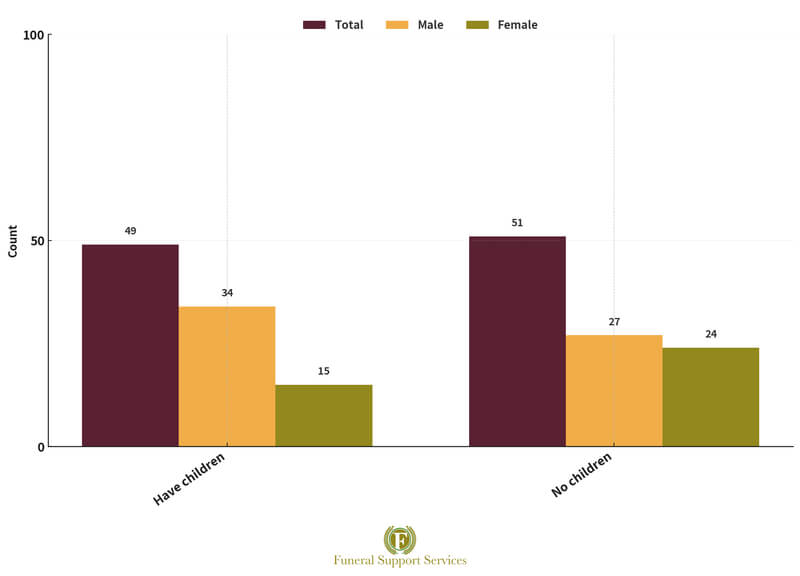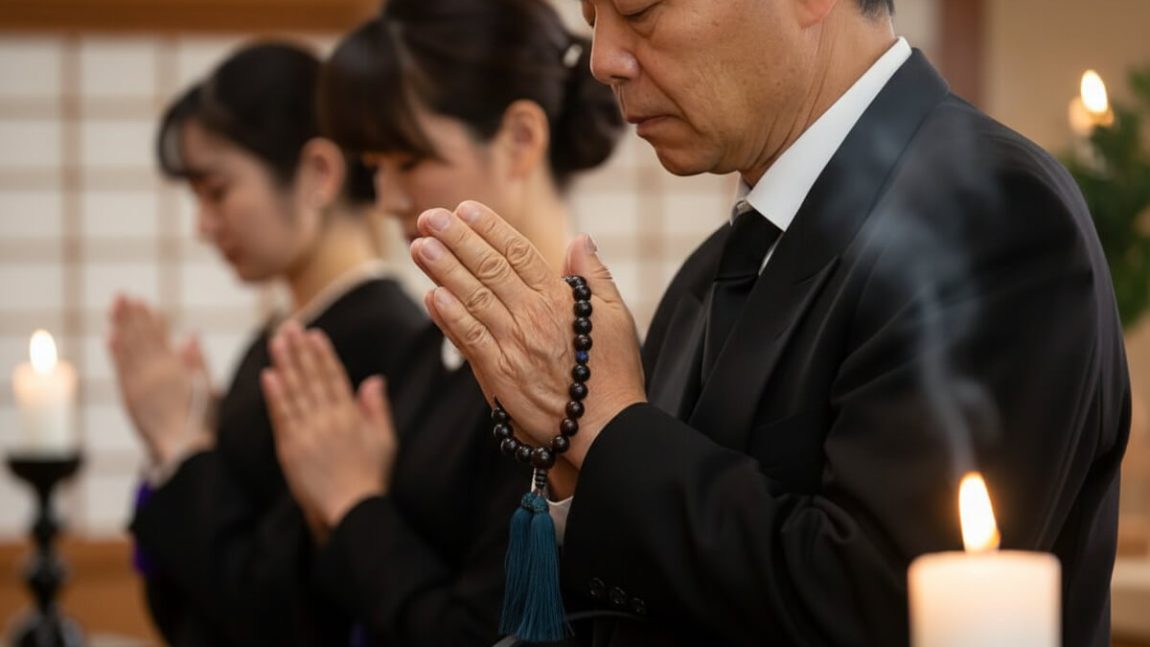INTRODUCTION
In recent years, interest in end-of-life planning—often referred to in Japan as “shūkatsu”—has grown steadily. However, how much are people actually preparing? What do they understand about wills, funerals, or legal procedures after death? To better understand public attitudes and concerns, Funeral Support Services (FSS) conducted two surveys in Japan in 2025.
The first was a nationwide screening survey with 1,000 participants, balanced across gender and age. This survey explored general attitudes toward end-of-life preparation, awareness of specific tasks (like writing a will or ending note), funeral preferences, and views on newer options such as direct cremation and tree burial. The second was a follow-up survey of 100 people, focusing on more detailed questions about embalming and post-death viewing practices.
The findings show a clear pattern: many people recognize the importance of preparing for death, but feel uncertain about where to begin. Cost transparency, ease of procedures, and reducing the burden on family emerged as top concerns. Preferences are shifting toward simpler, more personal approaches, and there is growing curiosity around alternatives to traditional funerals.
By sharing these results, FSS hopes to help raise awareness and encourage more people to take small, practical steps toward planning their future with confidence.
Specific takeaways
- Most people feel “I don’t know what to do” about end-of-life prep; a clear first-steps checklist (who to contact, what to prepare, in what order) will help more than broad explanations.
- Ending notes sound useful to many, but very few have started; a one-page starter they can fill out today would remove friction.
- Wills stall in two ways: some know the steps but haven’t acted, others don’t know where to start; each group needs a different nudge.
- Legal/financial tasks after a death are seen as important but overwhelming; readers want a plain-language sequence (who to call, in what order).
- Government/insurance/pension notifications are the biggest pain point; a “7-day / 30-day” action plan would be valued.
- People worry about burdening family; concrete burden-reducers (contact list, passwords, asset map, funeral preferences) beat abstract advice.
- Price clarity matters more than ceremony talk; readers want ballpark costs and what’s included.
- Preferred funerals are modest and simple (family-focused, quick); explain trade-offs: cost, speed, and time for goodbyes.
- Direct cremation isn’t widely viewed as “cold” if families add personal touches (home farewell, later memorial).
- Interest in tree/sea burials exists but is tentative; readers need legal steps, availability, and typical fees to move from curiosity to action.
- Non-religious funerals feel normal to many; sample formats (music, letters, photo boards) and timelines make it easier to picture.
- Online participation works best as an add-on for distant relatives, not a full substitute.
- Debate on dignified death/euthanasia is active but cautious; readers expect balanced, non-sensational coverage.
- If a Japanese person dies overseas, many see “cremate there, bring ashes home” as the most workable path; practical guidance (consulate, airline rules) is what they need.
- On embalming, people respond to purpose: transport, summer heat, longer gaps, and creating a calm, natural appearance for farewell.
- Seeing the face “depends on the condition” for many families; gentle guidance helps them decide without pressure.
- Pet funerals: a niche but curious audience—clear options and fees for first-timers would serve them well.
- Across topics, the real barrier isn’t values—it’s activation. Templates, checklists, and links to actual services are what move readers from “someday” to “done.”
Overall takeaways
- The main barrier is activation, not attitude: many think prep is good, but don’t start.
- Clarity lowers anxiety: where steps are clear (checklists, who to call), worry drops.
- Two big segments keep repeating:
- “Know but not done” and 2) “Don’t know where to start.” They need different nudges.
- A gender pattern appears in several areas: men skew “know but not done,” women skew “don’t know.” Tailor guidance accordingly.
- Cost beats ceremony: people want price ranges and what’s included more than style talk.
- Preference for simple, modest funerals fits the cost focus and “keep it easy” mindset.
- Post-death admin is the top pain point; this aligns with requests for checklists and timelines.
- Purpose-driven choices resonate: embalming and viewing are accepted when they serve a clear goal (hygiene, timing, “calm” appearance).
- Neutral answers are common across attitude items → readers lack information rather than oppose ideas.
- Alternative options (tree/sea burial) draw curiosity but low action—people need legality, availability, and fees to proceed.
- Online attendance is seen as an add-on, not a replacement—people want connection without losing the core farewell.
- For overseas deaths, “cremate there, bring ashes home” is favored—practicality wins.
- Burden on family is a steady concern; concrete tools (contact list, asset map, passwords) speak directly to it.
- Non-religious formats feel normalizing, matching the broader trend toward simpler, personalized farewells.
- Overall message: provide templates, price guides, and local service links—that’s what moves readers from “someday” to “done.”
Methods
To explore attitudes toward end-of-life planning in Japan, two nationwide surveys were conducted using the Freeasy platform in 2025. The research aimed to better understand public views on topics such as funeral preferences, embalming, and related concerns.
The first survey was administered on September 29, 2025, targeting 1,000 respondents residing in Japan, aged 20 to 99, including both men and women.
A follow-up survey was conducted on October 16, 2025, targeting 100 individuals from the initial sample who had expressed support for embalming under certain conditions. This second wave focused on further exploring their motivations, perceptions, and situational considerations surrounding embalming. Together, these two surveys provide a multi-layered view of Japanese perspectives on end-of-life decisions.
Results
Screening survey
Q1 Please tell us about your current situation regarding end-of-life preparation and planning.
Q1-1 General end-of-life planning

n_men = 589, n_women = 411
The data indicate most people either don’t know how to prepare for end-of-life planning (30.1%) or know what to do but haven’t acted yet (20.0%), while smaller shares are already preparing (7.5%) or plan to prepare in the future (18.6%); 23.8% say the question is not applicable to them. Overall, uncertainty or inaction is the dominant pattern: roughly half the sample either don’t know what to do or haven’t put plans into practice. A minority (~26%) are either already preparing or intend to do so.
No statistically significant differences between men and women were found for any response category, so male–female contrasts are not reported as significant.
Q1-2 Preparation of an ending note
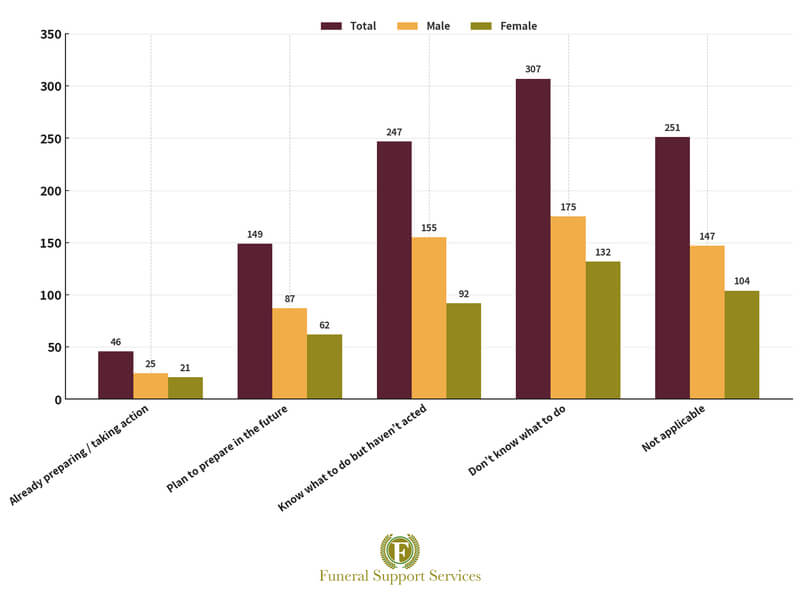
n_men = 589, n_women = 411
The data indicate low completion and substantial uncertainty: 30.7% report they don’t know what to do about ending-of-life paperwork, and 24.7% say they know what to do but haven’t acted yet. Smaller shares are planning to prepare (14.9%) or already taking action (4.6%), while 25.1% say the question is not applicable to them. Overall, inaction or uncertainty dominates — only about one in four are already preparing or plan to do so.
No statistically significant differences were found between men and women for any response category, so there are no reliable gender contrasts to report.
Q1-3 Preparation of a will
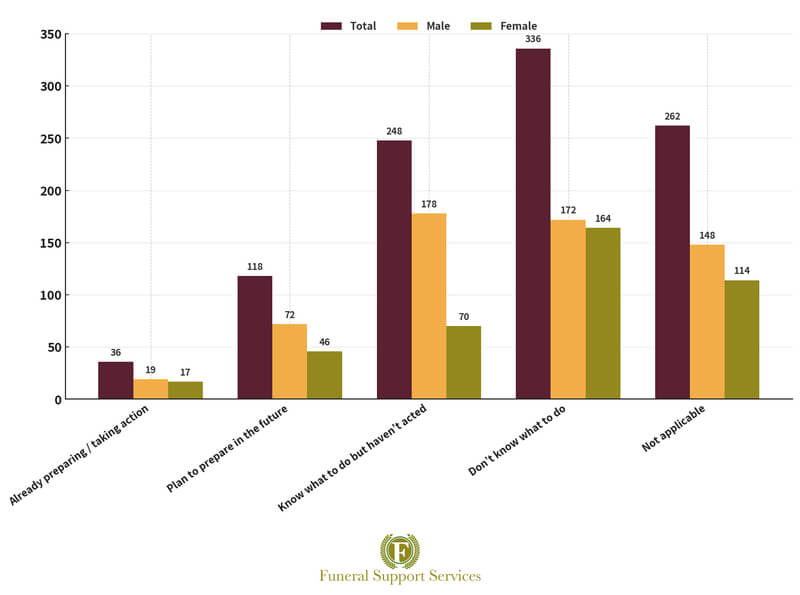
n_men = 589, n_women = 411
Overall Trends
The data show that will preparation is marked by high levels of uncertainty and inaction. The largest groups are those who either don’t know what to do (33.6%) or know what to do but haven’t acted (24.8%). Only a small share are already preparing (3.6%) or plan to prepare (11.8%), while about a quarter of respondents (26.2%) say the topic is not applicable to them. In total, nearly 58% are stalled at the stage of uncertainty or unimplemented intent, highlighting a widespread lack of progress.
Gender Differences
Two statistically significant gender differences emerged. Men are more likely to say they know what to do but haven’t acted yet (30.2% vs. 17.0%), while women are more likely to say they don’t know what to do (39.9% vs. 29.2%). These are the only response categories where the gender gap is statistically significant; other options showed no meaningful differences between men and women.
Interpretation
These results suggest a gendered pattern in readiness: men are more likely to be in a state of delayed action despite having knowledge, while women are more likely to feel unsure about how to begin. In both cases, a lack of concrete progress remains the norm.
Q1-4 Preparation for post-death legal and financial procedures

n_men = 589, n_women = 411
Overall Trends
The data reveal that concrete preparation for legal and financial matters after death is relatively uncommon. Over one-third of respondents (36.8%) say they don’t know what to do, and another 20.9% say they know what to do but haven’t acted. Only a small share are already preparing (3.9%) or plan to prepare (14.2%). About a quarter (24.2%) say the topic is not applicable to them. Altogether, roughly 58% are either unsure or inactive, indicating that most people have yet to take practical steps.
Gender Differences
Two statistically significant gender differences emerged. Men are more likely to say they know what to do but haven’t acted (24.1% vs. 16.3%), while women are more likely to say they don’t know what to do (41.8% vs. 33.3%). These are the only categories with significant gender gaps; other responses showed no meaningful differences between men and women.
Interpretation
The findings suggest a clear gender divide in readiness. Men tend to hesitate despite understanding the process, while women are more likely to feel unsure about what needs to be done. In both cases, actual preparation remains limited.
Q1-5 Preparation for post-death support services (public or private)

Overall Trends
The data show that preparation for post-death support services is limited. Over one-third of respondents (36.8%) say they don’t know what to do, and another 20.9% say they know what to do but haven’t acted. Only 3.9% are already preparing, and 14.2% say they plan to prepare. In total, about 58% are either unsure or inactive, indicating that concrete preparation for these services is not yet widespread.
Gender Differences
Two statistically significant gender differences were found. Men are more likely to say they know what to do but haven’t acted (24.1% vs. 16.3%), while women are more likely to say they don’t know what to do (41.8% vs. 33.3%). These are the only categories with statistically significant gender gaps; all other responses showed no meaningful differences.
Interpretation
The findings again highlight a gendered divide in readiness: men tend to delay action despite having awareness, while women more often report uncertainty. In both cases, actual planning for support services after death remains limited.
Q1-6 Countermeasures for family/relatives’ unattended graves or grave closure
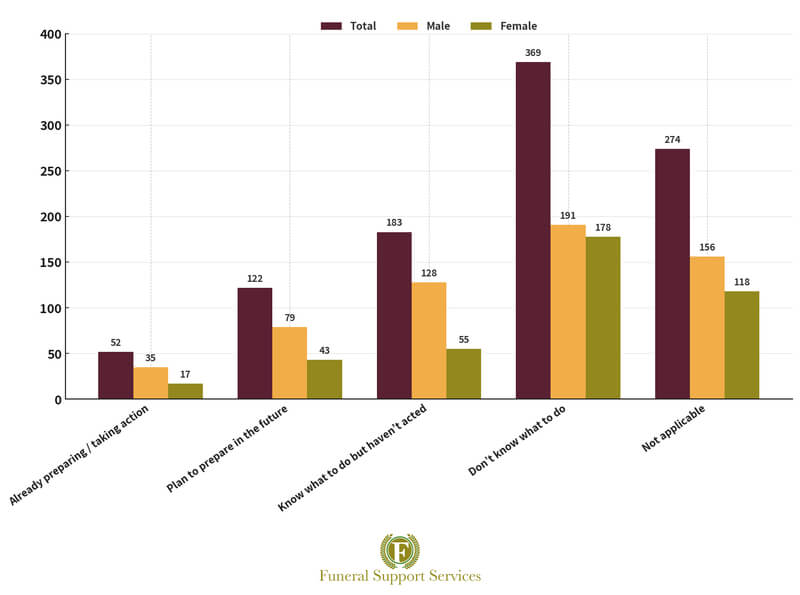
Overall Trends
The data show a familiar pattern of uncertainty and limited action. The largest group (36.9%) say they don’t know what to do, and another 18.3% know what to do but haven’t acted. Only 5.2% are already preparing, while 12.2% say they plan to prepare. About a quarter (27.4%) say the question is not applicable. Overall, uncertainty and inaction remain dominant, with few taking concrete steps.
Gender Differences
Two statistically significant gender differences emerged. Men are more likely to say they know what to do but haven’t acted (21.7% vs. 13.4%), while women are more likely to say they don’t know what to do (43.3% vs. 32.4%). These are the only categories where gender differences are significant; all other responses are similar between men and women.
Interpretation
As with earlier questions, a clear gendered pattern is visible. Men are more likely to delay action despite having knowledge, while women more often report a lack of awareness. In both cases, actual preparation for unattended grave issues remains low.
Q2 For each of the following items about death and loss, please choose the option closest to your opinion.
Q2-1 I am anxious about dying alone.
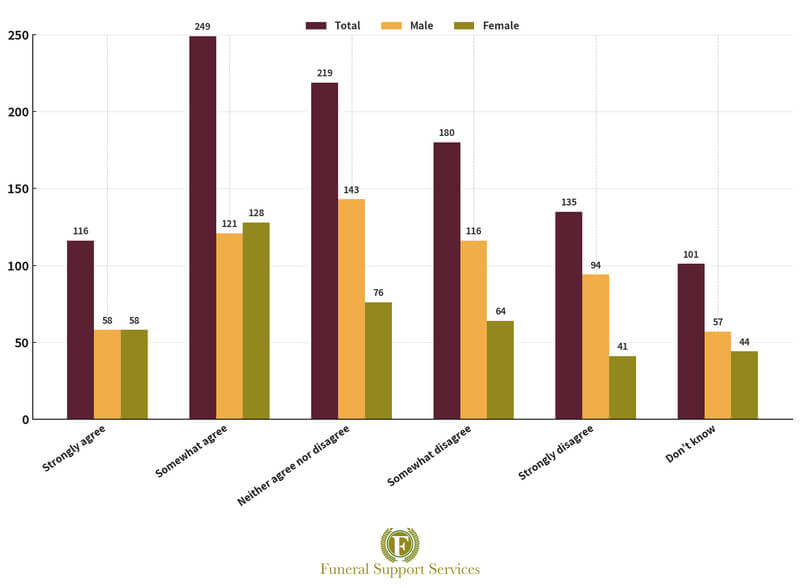
n_men = 589, n_women = 411
Overall Trends
Responses are divided on this issue. About one in three respondents (36.5%) say they feel anxious about dying alone, either strongly (11.6%) or somewhat (24.9%). On the other hand, 31.5% disagree to some degree (18.0% somewhat disagree, 13.5% strongly disagree). The remaining respondents are neutral (21.9%) or unsure (10.1%). In short, while a substantial group expresses anxiety, many are either unconcerned or undecided.
Gender Differences
Statistically significant gender differences were found in several response categories.
- Women are more likely than men to express anxiety:
- Somewhat agree: 31.1% of women vs. 20.5% of men
- Strongly agree: 14.1% of women vs. 9.9% of men
- Men are more likely to express neutrality or strong disagreement:
- Neither agree nor disagree: 24.3% of men vs. 18.5% of women
- Strongly disagree: 16.0% of men vs. 10.0% of women
No significant gender gaps were found in the other categories (somewhat disagree and don’t know).
Interpretation
These results highlight a gender divide in emotional response. Women are more likely to feel anxious about the possibility of dying alone, while men are more likely to feel neutral or to reject the idea more strongly. This suggests differing emotional attitudes toward solitude in later life.
Q2-2 I think grief care (support after loss) should be more widely available.

n_men = 589, n_women = 411
Overall Trends
The data show moderate support for expanding access to grief care. About 38.3% agree (11.2% strongly, 27.1% somewhat), while only 11.3% express disagreement. The largest single group is neutral at 33.8%, and 16.6% are unsure. While support is the most common stance, many respondents remain undecided or neutral.
Gender Differences
Only one statistically significant gender difference was found:
- Women are more likely than men to somewhat agree (30.7% vs. 24.6%).
No other response category shows a significant gender gap, so overall attitudes toward grief care are largely similar between men and women.
Interpretation
There is broad, though not overwhelming, support for making grief care more accessible. While women show slightly higher agreement, particularly in the “somewhat agree” range, the overall pattern suggests that both men and women are generally open to the idea, though many remain on the fence.
Q2-3 Having clear post-death procedures gives me peace of mind.
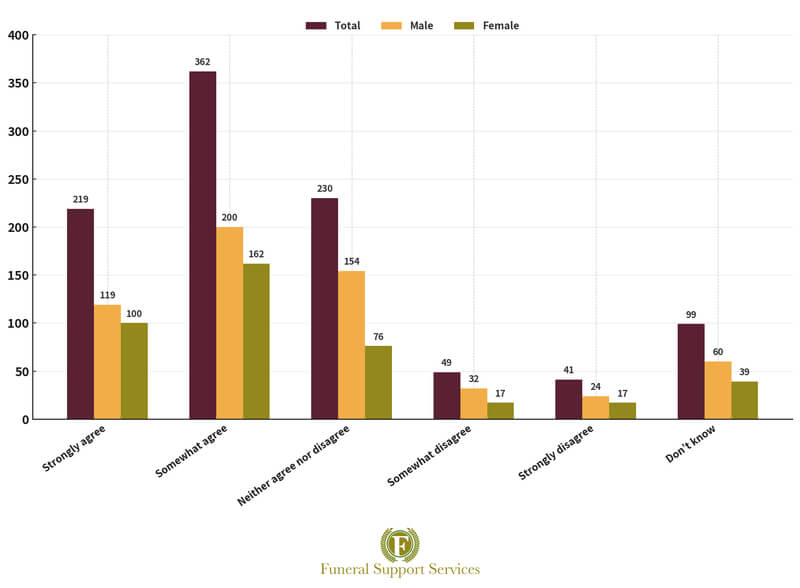
Overall Trends
Most respondents feel reassured by the idea of having clear post-death procedures. A total of 58.1% agree (21.9% strongly, 36.2% somewhat), while only 9.0% express disagreement. Another 23.0% are neutral, and 9.9% are unsure. Overall, clarity around what happens after death appears to provide significant peace of mind, especially for those who moderately agree.
Gender Differences
Only one statistically significant gender difference was observed:
- Men are more likely to be neutral on the topic (26.2% vs. 18.5%).
There were no meaningful gender differences in agreement, disagreement, or uncertainty.
Interpretation
The results suggest that most people value having a clear plan for post-death procedures. While men are more likely to take a neutral stance, the overall trend points to a widespread sense of comfort that comes with clarity.
Q2-4 I worry about being a burden to my family after I die.

n_men = 589、n_women = 411
Overall Trends
Half of all respondents express concern about being a burden to their family after death. In total, 50.6% agree (18.0% strongly, 32.6% somewhat), while 15.5% disagree. Another 24.4% are neutral and 9.5% don’t know. Overall, this is a common worry, though a sizable group remains indifferent or unsure.
Gender Differences
Statistically significant gender differences appear in a few areas:
- Women are more likely to agree overall (56.2% vs. 46.7%)
- Women are also more likely to strongly agree (20.9% vs. 16.0%)
- Men are more likely to be neutral (26.8% vs. 20.9%)
Other response categories do not show meaningful gender gaps.
Interpretation
The concern about being a burden is widely shared but tends to be felt more strongly by women. Men, on the other hand, are more likely to take a neutral stance, indicating less emotional engagement or uncertainty around the issue.
Q2-5 I want to leave behind written wishes to reduce the burden on others.
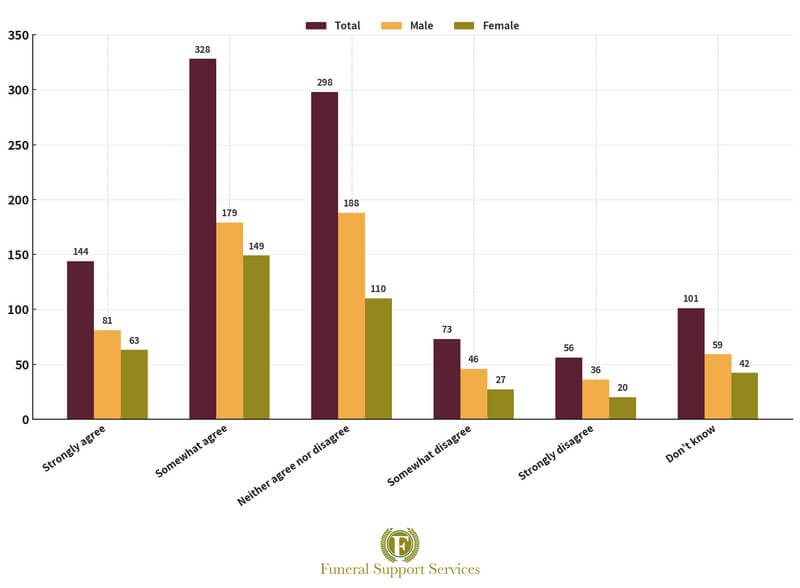
n_men = 589、n_women = 411
Overall Trends
Nearly half of all respondents support the idea of leaving written wishes to ease the burden on others. A total of 47.2% agree (14.4% strongly, 32.8% somewhat), while 12.9% disagree. The largest single group is neutral at 29.8%, and 10.1% are unsure. Overall, most people lean toward documenting their wishes, although many have yet to form a clear opinion.
Gender Differences
No statistically significant gender differences were found. Men and women responded similarly across all categories.
Interpretation
There is broad support for the idea of writing down personal wishes to prevent burdening others, though many remain undecided. The absence of gender differences suggests that this sentiment is widely shared across the population.
Q3 Please choose the funeral style closest to your preference.

n_men = 589、n_women = 411
Overall Trends
The data show clear preferences regarding funeral style. The most common choice is a family funeral (40.7%), followed by direct cremation with no ceremony (26.3%). About one in five respondents are unsure (20.4%). Traditional large funerals (5.7%) and non-religious funerals (6.4%) are far less common. In short, small and private ceremonies are by far the most preferred, while a significant minority opt for no ceremony at all. A notable portion of respondents remain undecided.
Gender Differences
Two statistically significant gender differences were found:
- Men are more likely to prefer a traditional large funeral (7.1% men vs. 3.7% women).
- Women are more likely to prefer a non-religious funeral (8.3% women vs. 5.1% men).
Other preferences (family funeral, direct cremation, unsure, or other) do not differ significantly by gender.
Interpretation
Most people favor simpler, more intimate funerals over formal or traditional options. Gender plays a role at the edges: men lean slightly more toward traditional formats, while women are more open to non-religious styles. But overall, the trend toward smaller, less ceremonial funerals is consistent across genders.
Q4 Please choose the amount you feel is appropriate as a total funeral budget.
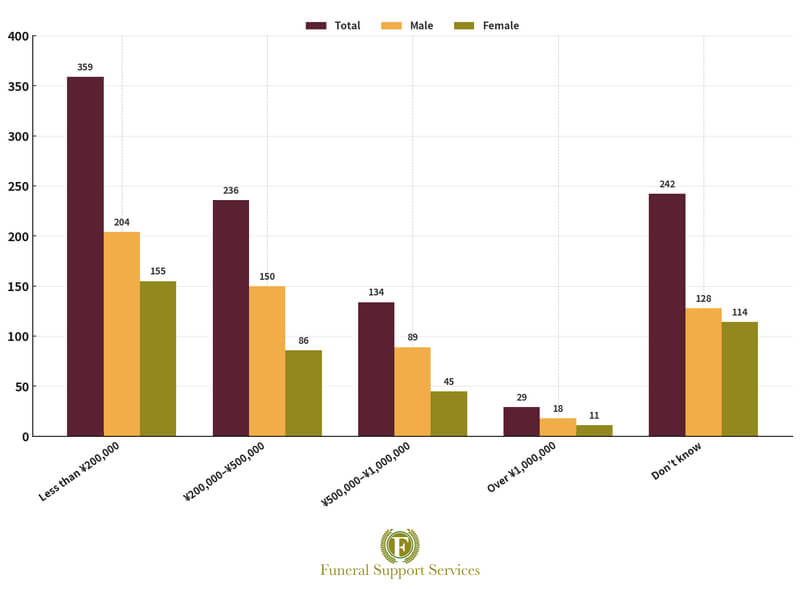
n_men = 589、n_women = 411
Overall Trends
The data show that most people view a modest funeral budget as appropriate. About one-third (35.9%) feel under ¥200,000 is reasonable, and another 23.6% select ¥200,000–¥500,000. In contrast, only 13.4% opt for ¥500,000–¥1,000,000, and just 2.9% choose over ¥1,000,000. Notably, 24.2% say they don’t know. Overall, low-to-mid-range budgets are the norm, but a substantial number of respondents remain unsure about what amount is appropriate.
Gender Differences
Only one statistically significant gender difference emerged: women are more likely than men to say they don’t know (27.7% vs. 21.7%). All other budget categories show no meaningful gender gaps.
Interpretation
Most people prefer to keep funeral costs modest, and very few favor expensive arrangements. The fact that a quarter of respondents are unsure suggests that many may not have considered the financial side of funerals in detail. Women in particular seem more likely to feel uncertain about funeral budgeting.
Q5 What is the most important factor for you in funerals or post-death procedures?

n_men = 589、n_women = 411
The data indicate that clear and reasonable costs are by far the top priority (50.0%), followed by simplicity of procedures and paperwork (21.4%) and respecting the deceased’s wishes (19.5%); religious traditions and consideration for attendees rank much lower. Overall, pragmatic concerns about cost and administrative ease dominate respondents’ priorities around funerals and post-death procedures.
There are no statistically significant differences between men and women across these response options, so gender-based contrasts are not meaningful in this item.
Overall trends
The data show that clear and reasonable costs are by far the top priority (50.0%). This is followed by simplicity of procedures and paperwork (21.4%) and respecting the deceased’s wishes (19.5%). In contrast, religious traditions and consideration for attendees were much less frequently selected. Overall, practical concerns — especially cost and administrative simplicity — dominate what people value most in funerals and post-death arrangements.
Gender differences
There are no statistically significant differences between men and women across any of the response options. This suggests that priorities around funerals and post-death procedures are broadly shared regardless of gender.
Interpretation
The findings suggest that for many, funerals are not primarily about ceremony or tradition. Instead, they are seen through a practical lens — minimizing cost and complexity for those left behind.
Q6 Which type of administrative support do you think is most necessary after death?

n_men = 589、n_women = 411
Overall trends
Most respondents clearly prioritize help with formal procedures: 58.2% say they want support with government, insurance, or pension paperwork. Other needs are mentioned far less often — only 9.6% want access to a 24-hour consultation desk, 8.6% seek help comparing estimates or plans, and just 4.0% want assistance with translations or document preparation. About one in five (19.6%) say they don’t need any administrative support. Overall, the results show a strong demand for practical help navigating official systems.
Gender differences
Two gender gaps are statistically significant. Men are more likely to want support with translation and document preparation (5.1% of men vs 2.4% of women), and also more likely to say they don’t need any support (22.6% of men vs 15.3% of women). Other differences are not significant.
Interpretation
Administrative tasks after death can be complex, and most people want help dealing with formal procedures. However, some — especially men — feel confident handling things on their own or prefer minimal involvement.
Q7 For each of the following funeral and memorial options, please choose the option closest to your opinion.
Q7-1 I think sea burials are a dignified way of memorializing.

n_men = 589、n_women = 411
Overall trends
Responses show mixed views on sea burials. About one-third (32.7%) agree to some extent, while the largest group is neutral (37.4%). Another 15.6% disagree, and 14.3% say they don’t know. Overall, cautious openness is common, but many remain undecided.
Gender differences (statistically significant only)
Women are more likely to “somewhat agree” (26.8% of women vs 18.3% of men), suggesting more openness toward sea burials. Men are more likely to be neutral (40.2% of men vs 33.3% of women) or to “strongly disagree” (5.6% of men vs 2.7% of women). No other response category shows a significant gender difference.
Interpretation
Sea burials are not widely embraced, but they are not strongly rejected either. Most people either accept the idea with caution or have not made up their minds. Women tend to be slightly more accepting, while men show more hesitation or opposition.
Q7-2 I think tree burials should become more common as an eco-friendly option.
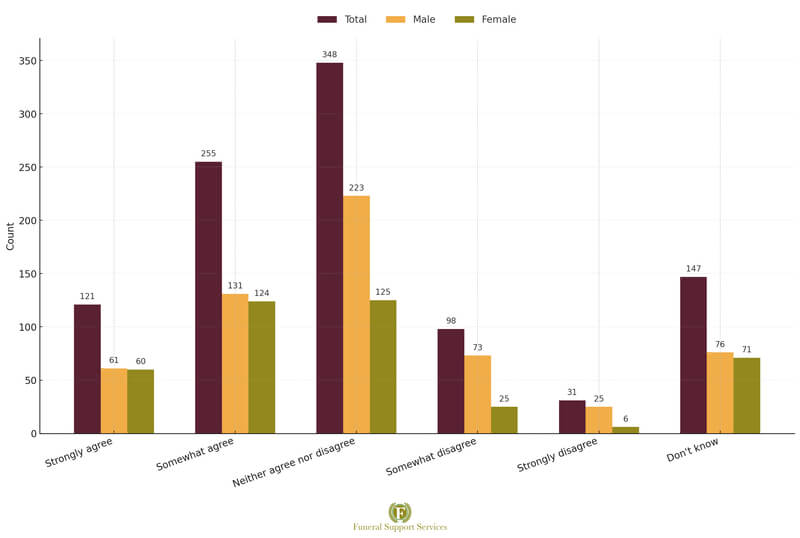
n_men = 589、n_women = 411
Overall trends
The data show mild support for tree burials as a sustainable alternative. A total of 37.6% of respondents agree to some extent, while 12.9% disagree. About 34.8% are neutral and 14.7% say they don’t know. Overall, people lean slightly positive, but many remain undecided.
Gender differences (statistically significant only)
There are several significant gender differences. Women are more likely to support tree burials: 14.6% of women “strongly agree” compared to 10.4% of men, and 30.2% of women “somewhat agree” vs 22.2% of men. In contrast, men are more likely to be neutral or skeptical: 37.9% of men are neutral compared to 30.4% of women, 12.4% of men “somewhat disagree” vs 6.1% of women, and 4.2% of men “strongly disagree” vs 1.5% of women. The share who say “don’t know” is similar between genders.
Interpretation
While tree burials are viewed positively overall, strong support is limited. Women tend to be more open to this eco-conscious option, while men show more hesitation or neutrality. Many respondents are still unsure, suggesting room for greater awareness.
Q7-3 I think non-religious funerals should be more widely accepted in Japan.
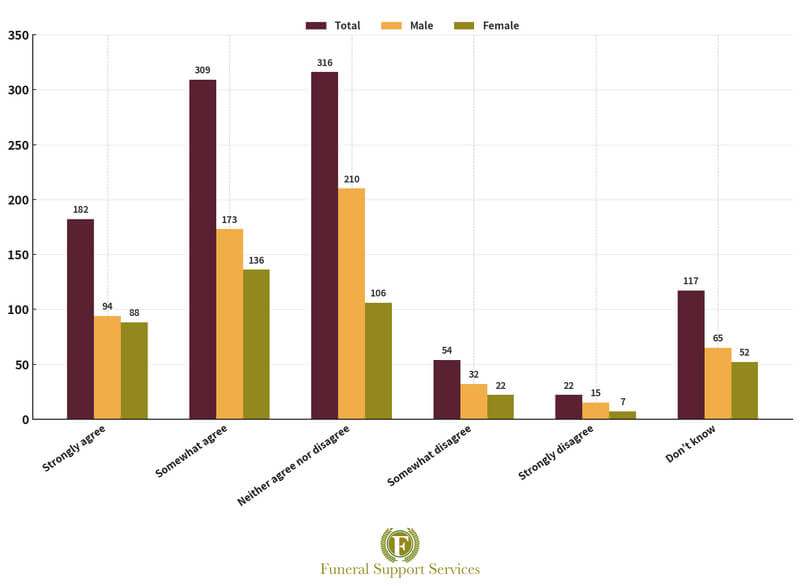
n_men = 589、n_women = 411
Overall trends
Roughly half of respondents support wider acceptance of non-religious funerals (18.2% strongly agree, 30.9% somewhat agree). Meanwhile, 31.6% are neutral, 7.6% disagree, and 11.7% say they don’t know. Overall, the majority lean toward acceptance, but many remain undecided or neutral.
Gender differences
There are two statistically significant gender differences. Women are more likely to strongly agree (21.4% of women vs 16.0% of men), while men are more likely to respond neutrally (35.7% of men vs 25.8% of women). Other response categories do not show significant gender gaps.
Interpretation
While non-religious funerals are not yet mainstream in Japan, many people — especially women — view them positively. A large portion of the population remains neutral, suggesting that awareness and familiarity with non-religious options could help shift attitudes further.
Q7-4 Direct cremations (funerals without a wake or farewell ceremony) feel cold.

n_men = 589、n_women = 411
Overall trends
The data indicate that direct cremations are not widely perceived as cold. While 20.6% of respondents agree with the statement, a larger share (36.9%) disagree, and the most common single response is neutral (32.6%). Additionally, 9.9% say they don’t know. This suggests that direct cremation is not strongly associated with emotional coldness, although a significant portion of respondents remain neutral or uncertain.
Gender differences
There are no statistically significant differences between men and women for this question. Perceptions of direct cremation appear broadly similar across genders.
Interpretation
Direct cremations, which skip traditional ceremonies, are not strongly rejected by the public. While some do see them as lacking warmth, more people disagree than agree — and many remain neutral. These results suggest that public attitudes toward simplified funerals are shifting, with emotional judgments like “coldness” giving way to more practical acceptance.
Q7-5 I think online funerals and memorial services are appropriate substitutes for in-person ones.

n_men = 589、n_women = 411
Overall Trends
The data suggest limited support for online funerals as full replacements for in-person ceremonies. Only 21.8% agree (5.0% strongly, 16.8% somewhat), while 44.0% remain neutral and 21.0% express disagreement (14.4% somewhat, 6.6% strongly). Another 13.2% are unsure. Overall, most respondents are either undecided or cautious, with only a small portion expressing clear support.
Gender Differences
Statistically significant gender differences appear in opposition rates. Men are more likely to disagree, with 16.3% somewhat disagreeing (vs 11.7% of women) and 8.0% strongly disagreeing (vs 4.6% of women). Other response categories show no statistically significant differences between men and women.
Interpretation
Most people appear hesitant about treating online funerals as appropriate substitutes for in-person ones. While some support exists, a large neutral group suggests that acceptance is still tentative. The format may be seen as useful in specific situations, but it has yet to gain broad emotional or cultural endorsement.
Q7-6 I think burials should also be allowed in Japan.
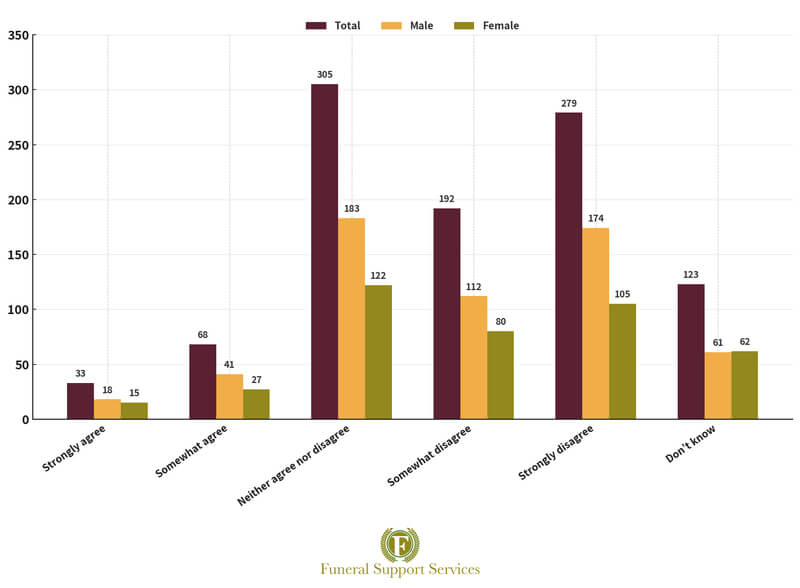
n_men = 589、n_women = 411
Overall trends
The data show that most respondents do not support allowing burials in Japan. Nearly half (47.1%) oppose it, while only 10.1% are in favor. The largest single group is neutral at 30.5%, and 12.3% say they don’t know. In short, public opinion leans toward opposition, with few in clear support and many either undecided or neutral.
Gender differences
Only one statistically significant difference emerged: women are more likely than men to say they don’t know (15.1% of women vs 10.4% of men). Support and opposition rates are otherwise similar across genders.
Interpretation
Burial remains a sensitive and unfamiliar option in Japan, where cremation is the cultural norm. The data reflect low support for change, with resistance and uncertainty dominating the discussion. Calls to reintroduce burial as a more accessible alternative are unlikely to find widespread backing under current sentiment.
Q7-7 I think dignified death and euthanasia should be legalized.

n_men = 589、n_women = 411
Overall trends
The data indicate a cautious majority in favor of legalization. A total of 41.0% agree to some extent (16.4% strongly agree, 24.6% somewhat agree), while 37.9% are neutral. Only 9.5% are opposed, and 11.6% say they don’t know. In short, public sentiment leans toward support, but with a large group that remains undecided or neutral.
Gender differences
There are no statistically significant gender differences in any of the response categories. Men and women show similar patterns of opinion on this topic.
Interpretation
Dignified death and euthanasia remain sensitive and complex topics, but the data suggest a shift toward cautious acceptance in Japan. While strong opposition is rare, many respondents are either neutral or still forming an opinion. This reflects a broader societal readiness for discussion, even if consensus is not yet reached.
Q7-8 I think repatriation of remains is important when Japanese people die overseas.
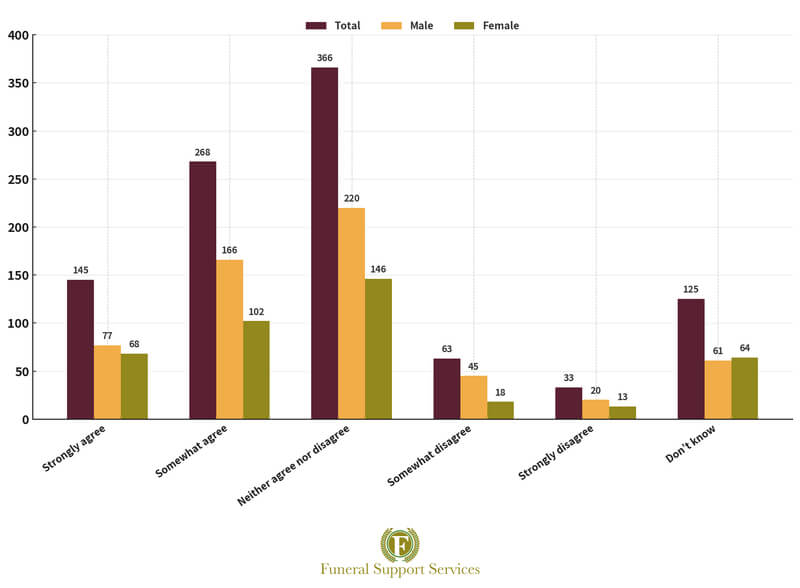
n_men = 589、n_women = 411
Overall trends
The data indicate that a plurality of respondents are neutral on the topic: 36.6% chose “neither agree nor disagree.” Support is somewhat higher at 41.3% (14.5% strongly agree + 26.8% somewhat agree), while 9.6% oppose it and 12.5% say they don’t know. Overall, there is moderate sympathy for repatriation, but a large middle group remains undecided or neutral.
Gender differences
Only one statistically significant gender difference was found: women are more likely than men to answer “don’t know” (15.6% vs 10.4%). Support, neutrality, and opposition rates are otherwise similar between men and women.
Interpretation
While many Japanese people seem to understand the importance of repatriating remains, the issue doesn’t evoke strong emotions. Cultural expectations, logistical challenges, and the globalized nature of modern life may all contribute to the relatively high levels of neutrality and uncertainty seen in the data.
Q7-9 I think the customs of the deceased person’s home country should be considered when foreigners die in Japan.
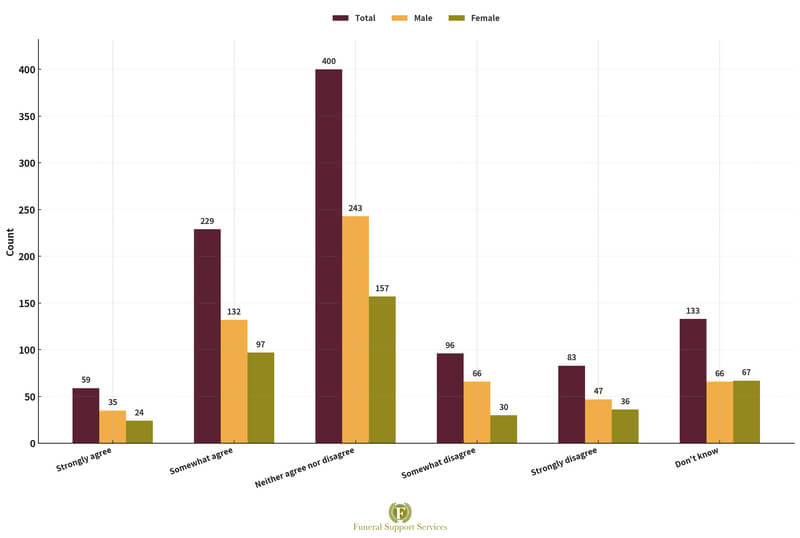
n_men = 589、n_women = 411
Overall trends
Most respondents were neutral on this question, with 40.0% selecting “neither agree nor disagree.” About 28.8% expressed some level of agreement (5.9% strongly agree + 22.9% somewhat agree), while 17.9% expressed opposition. A notable 13.3% chose “don’t know.” Overall, there is a modest level of support for considering foreign customs, but neutrality and uncertainty remain substantial.
Gender differences
A single statistically significant gender difference was observed: women were more likely than men to choose “don’t know” (16.3% vs 11.2%). Other response categories showed no significant gender-based differences.
Interpretation
While there is some support for incorporating the customs of a deceased foreigner’s home country, this issue does not appear to be widely settled in the minds of many respondents. The large neutral and unsure segments suggest limited familiarity or confidence in how to approach such multicultural considerations during emotionally sensitive times.
Q7-10 I think embalming is necessary when transporting remains long distances.

n_men = 589、n_women = 411
Overall trends
A clear majority of respondents support embalming in the case of long-distance body transport: 54.9% agreed (24.1% strongly + 30.8% somewhat). About 27.8% were neutral, while only 5.6% expressed opposition. A further 11.7% selected “don’t know.” This indicates that most people either support the idea or are neutral—outright rejection is minimal.
Gender differences
Only one gender difference was statistically significant: men were slightly more likely to “strongly agree” than women (25.1% vs 22.6%). All other response categories showed no meaningful gender gap.
Interpretation
Public sentiment strongly favors embalming for long-distance transport, suggesting that logistical and sanitary considerations resonate with the public. The fact that nearly all respondents fall into agreement or neutrality—with little active opposition—may indicate widespread understanding or acceptance of embalming in this specific practical context.
Q8 Please tell us your experience with professional pet funerals and memorial services.

n_men = 589、n_women = 411
Overall trends
A clear majority (64.3%) reported not having pets. Among respondents with pet experience, 12.7% had used professional pet funeral services and were satisfied — the most common experience. Smaller proportions reported encountering issues (4.9%), being open to it in the future (9.6%), or not considering it (8.5%). Overall, while professional pet funeral use is relatively uncommon, positive experiences outnumber negative ones.
Gender differences
No statistically significant gender differences were observed. Response distributions between men and women were similar across all categories.
Interpretation
Professional pet funeral services remain niche, likely due to the high number of people without pets. However, among those who have used such services, satisfaction is relatively high. The lack of gender differences suggests views on pet memorials are not strongly shaped by gender, but rather by pet ownership and personal preferences.
Q9 What do you think is the most appropriate response when a Japanese person dies overseas?

n_men = 589、n_women = 411
Overall trends
The data reveal a notable level of uncertainty: 30.8% of respondents selected “don’t know,” the largest single group. Among concrete options, the most common was cremating the body locally and returning the ashes to Japan (26.0%). This was followed by deciding based on costs, local laws, and timing (21.2%), and transporting the body to Japan for funeral and cremation (19.0%). Only 3.0% supported leaving the ashes in the country where the death occurred. Overall, responses suggest a tendency to bring remains or ashes back to Japan, or to take a pragmatic case-by-case approach—though many remain undecided.
Gender differences
No statistically significant gender differences were observed across the five options. Men and women responded similarly, so there are no notable gender-based disparities to report.
Interpretation
When Japanese people die abroad, public opinion tends to favor repatriation of the body or ashes—but with a strong undercurrent of uncertainty. This ambiguity may reflect a lack of familiarity with procedures or legal frameworks. The absence of gender differences suggests these views are widely shared, regardless of demographic background.
Q10 Please choose the statement that best reflects your opinion on embalming.
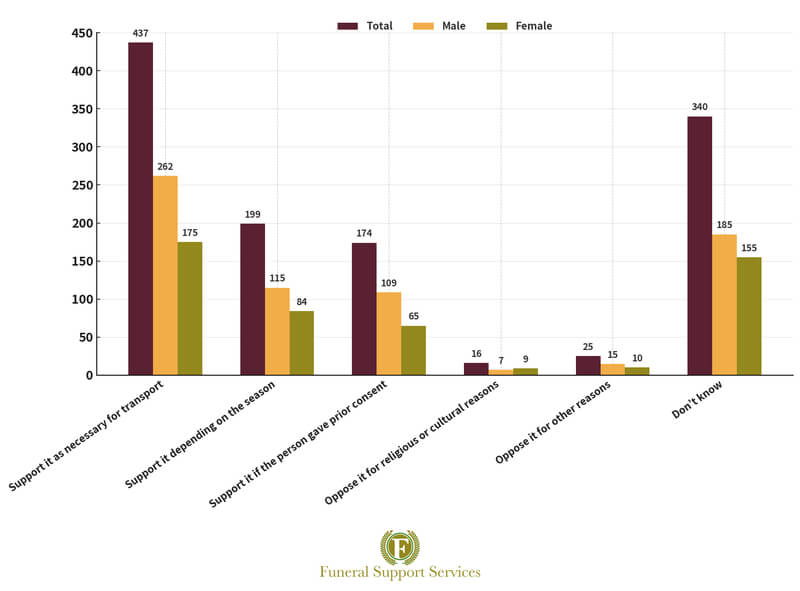
n_men = 589、n_women = 411
Overall trends
The data indicate that most respondents broadly accept embalming for practical reasons: 43.7% support it as a necessary measure for transporting remains, while smaller shares support seasonal use (19.9%) or conditional use with prior consent (17.4%). Substantial uncertainty remains, with 34.0% answering “don’t know.” Opposition is very small—only about 1.6% oppose embalming for religious or cultural reasons, and 2.5% for other reasons. Overall, acceptance outweighs rejection by a large margin, though uncertainty remains notable.
Gender differences
The results show one gender difference: women are more likely to answer “don’t know” (about 37.7% of women vs. 31.4% of men). No other response category shows a meaningful gender gap.
Interpretation
Most people see embalming as a practical solution for specific situations like long-distance transport. Conditional acceptance—based on season or prior consent—is also notable, while outright opposition is rare. However, the high share of “don’t know” responses signals unfamiliarity or hesitation among a significant portion of the population, especially among women. This suggests room for greater public education or clarity around embalming practices.
Follow-up survey
Q1 This question is for those who previously answered “I support embalming (depending on the season).”If postmortem treatment allows the deceased to appear peaceful and lifelike, do you think it would make it easier to say goodbye? (SA)

n_men = 61、n_women = 39
Overall trends
The data indicate that most respondents would feel positively—or at least conditionally positively—about embalming if it helps the deceased appear peaceful and lifelike during the farewell. A plurality (46%) said, “It depends, but I would feel positive,” and another 37% said, “I think it would make the farewell more comforting.” A smaller group (12%) expressed a preference for a natural, untreated appearance, and 5% said they were unsure. In short, conditional acceptance dominates, and outright preference for a natural state is rare.
Gender differences
There are no statistically significant differences between men and women in their responses. The distribution across the four answer options is broadly similar for both genders, indicating that gender does not meaningfully shape opinion on this question.
Interpretation
While embalming remains a sensitive topic, this subset of respondents—those already open to seasonal use—are largely supportive of treatments that create a peaceful final image. For many, the emotional value of a comforting farewell outweighs a strict preference for natural appearance. This suggests that visual presentation may be a key factor in shaping perceptions of postmortem care.
Q2 Do you think improving the appearance of the deceased is an important part of a funeral? (SA)

n_men = 61、n_women = 39
Overall trends
The data indicate that a large majority consider improving the deceased’s appearance to be important in the context of a funeral. A combined 85% agree: 27% “strongly agree” and 58% “somewhat agree.” In contrast, only 9% “somewhat disagree,” 3% “think it’s unnecessary,” and another 3% are “unsure.” This shows that most respondents place value on a dignified appearance at farewell.
Gender differences
There are no statistically significant differences between men and women in their responses. Both groups show similar levels of agreement, indicating that the importance of appearance in funeral settings is widely recognized regardless of gender.
Interpretation
These results suggest that preparing the deceased in a respectful and visually comforting way is seen as an essential part of the mourning process. For many, appearance plays a key role in providing closure, expressing respect, and facilitating a peaceful farewell.
Q3-1 What is your current impression of embalming?

n_men = 61、n_women = 39
Overall trends
The data indicate that impressions of embalming are largely positive. About 32% of respondents report having a good impression and 46% a somewhat good impression, totaling approximately 78% who hold either a positive or mildly positive view. Only a small share—around 11%—express some resistance or strong resistance, while another 11% say they don’t know. This suggests that embalming is generally accepted or viewed favorably among this group, with only limited hesitation or opposition.
Gender differences
The results show no statistically significant differences between men and women. Response patterns are similar across the five categories. For example, “somewhat good” was selected by 42.6% of men and 51.3% of women. Therefore, gender does not appear to meaningfully affect impressions of embalming in this case.
Interpretation
These findings imply that once respondents are filtered to those already open to the idea of embalming (from the screening survey), most hold broadly favorable views. This positive sentiment suggests that awareness or limited prior exposure may reduce resistance and foster acceptance. It also indicates a base of potential support for wider public education or services involving embalming, provided the audience is already somewhat receptive.
Q3-2 If embalming could make the complexion and facial expression look natural and calm, how would you feel about it?

n_men = 61、n_women = 39
Overall trends
The data indicate that most respondents would react positively if embalming could produce a natural and calm appearance. A combined 86% say their impression would be good (40%) or somewhat good (46%). Only a small minority express some resistance (about 7%), while another 7% say they are unsure. Overall, when the result is described as lifelike and peaceful, public acceptance increases significantly.
Gender differences
There are no statistically significant differences between men and women on this item. Both genders report nearly identical levels of positive response — with men and women showing similar rates of “good” and “somewhat good” impressions — so gender does not meaningfully affect perceptions in this case.
Interpretation
This result suggests that public perceptions of embalming can shift depending on how the outcome is framed. If the procedure is associated with a more peaceful and natural appearance, many people — even those previously uncertain — respond favorably. This highlights the importance of clear communication and visual examples when educating the public about postmortem care practices.
Q4 Regarding viewing the deceased’s face during the funeral, which opinion is closest to yours? (SA)

n_men = 61、n_women = 39
Overall Trends
The data indicate that most respondents hold either supportive or conditionally supportive views about viewing the deceased’s face during the funeral. The largest group (40%) said it depends on the condition of the body, while 33% regard it as an important part of saying goodbye. Only 1% prefer not to view the face, while 23% believe the decision should be left to each attendee and 3% are unsure. Overall, three-quarters of respondents lean toward acceptance of face-to-face viewing, either directly or under certain conditions.
Gender Differences
Our analysis finds no statistically significant differences between men and women in their responses. The distribution across all answer choices is similar for both genders, indicating that gender does not meaningfully affect perspectives on this issue.
Interpretation
This question reveals a generally accepting stance toward face viewing during funerals, especially when appropriate conditions are met. While a small minority express discomfort or uncertainty, most view it as either a meaningful ritual or a matter of personal choice. This reflects both cultural flexibility and an awareness of the importance of visual farewell in the grieving process.
Q5 In which situations do you think embalming is especially necessary? (MA)

n_men = 61、n_women = 39
Overall trends
The data indicate that embalming is considered especially necessary in practical and time-sensitive contexts. The most frequently cited reason is during summer or hot weather (72%), followed by when transporting the body over long distances (62%) and when several days pass before the funeral (61%). Emotional and international reasons are somewhat less common but still significant: when wishing to view the deceased’s face for farewell (38%) and when the body must be repatriated overseas (33%). Only 8% of respondents selected “don’t know,” indicating most respondents have clear opinions.
Gender differences
There are no statistically significant gender differences across any of the listed situations. The male and female response rates are similar, and none of the differences reach a level suggesting a meaningful gender-based effect. This consistency suggests a shared understanding across genders of when embalming is seen as necessary.
Interpretation
Respondents primarily view embalming through a pragmatic lens: high temperatures, transportation needs, and time gaps between death and funeral are the strongest motivators. Cultural or emotional reasons such as viewing the body or international repatriation are secondary but still present. The small percentage of “don’t know” responses further reinforces that most people have a defined view of when embalming is appropriate.
Conclusion
This survey shows a growing awareness in Japan about the importance of preparing for the end of life—but also reveals just how many people feel unsure about how to begin. Whether it’s writing a will, filling out an ending note, deciding on funeral preferences, or handling after-death paperwork, the common pattern is hesitation due to lack of clear guidance.
Interestingly, many respondents said they “understand the need” but haven’t taken action. Others don’t even know what steps to take. These findings suggest that the issue is not unwillingness, but uncertainty. Simple tools—like checklists, contact guides, or price examples—may be far more helpful than general advice.
We also saw gender-based patterns: men often reported knowing what to do but hadn’t started, while women were more likely to feel unsure about the process. This points to the need for different kinds of support, depending on the individual.
The data also reflects shifting values. Simpler funerals are preferred over elaborate ceremonies, and there’s growing openness to options like direct cremation, tree burials, or non-religious formats. Above all, people are looking for peace of mind, fairness in cost, and ways to reduce the burden on family.
As a company that specializes in these matters, we at Funeral Support Services felt it was important to better understand how people in Japan are thinking and feeling about these topics. We hope this data helps raise awareness and encourages more people to take small, practical steps—at their own pace—toward planning for the future.
Demographics
Screening survey
Age group

Prefecture

Gender

Marital status

Occupation

Industry
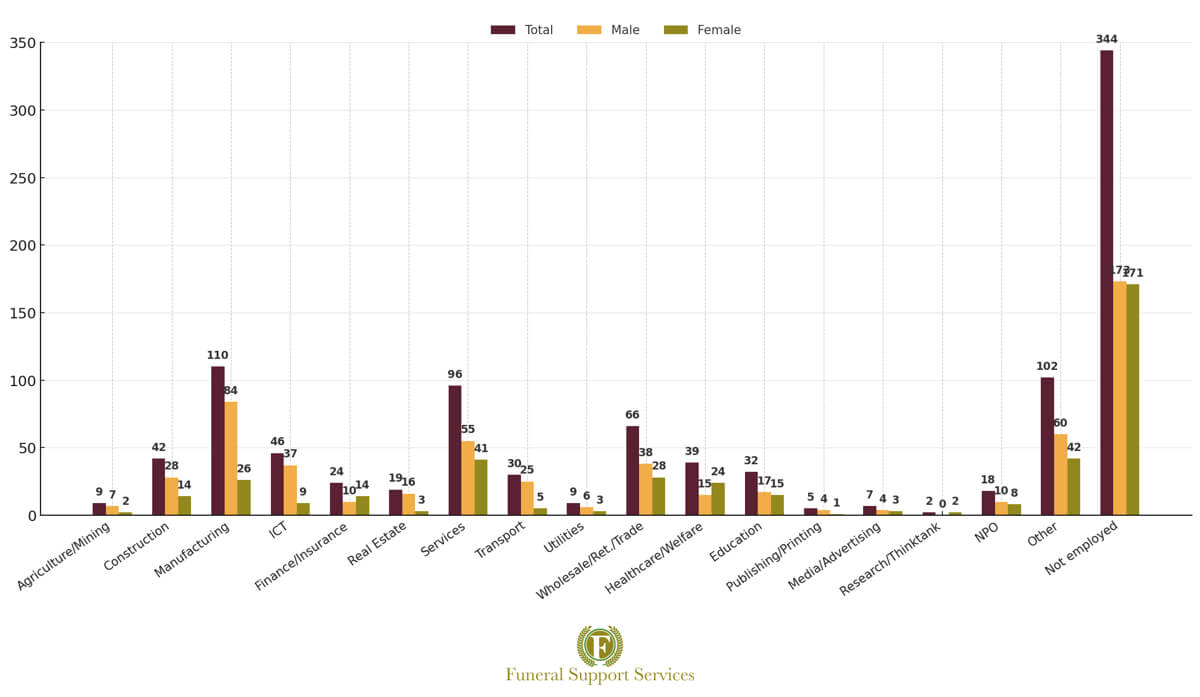
Household income

Housing type

Presence of children

Follow-up survey
Age group
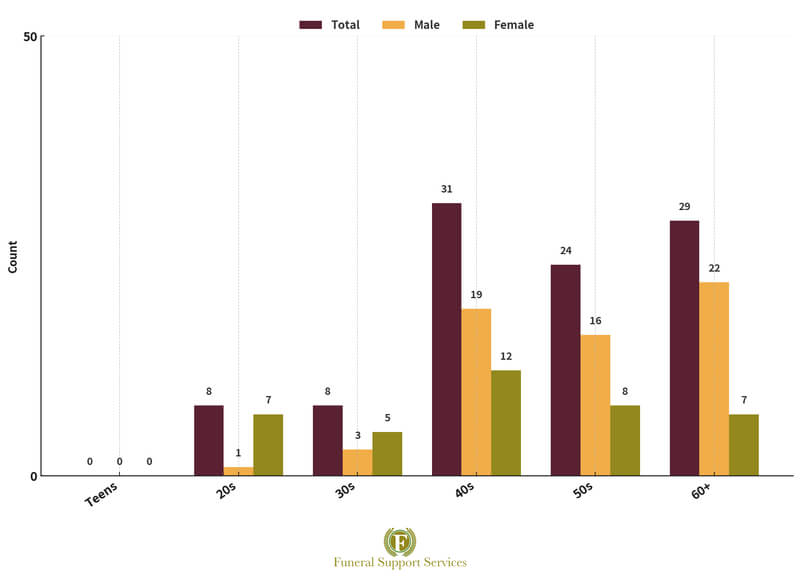
Prefecture
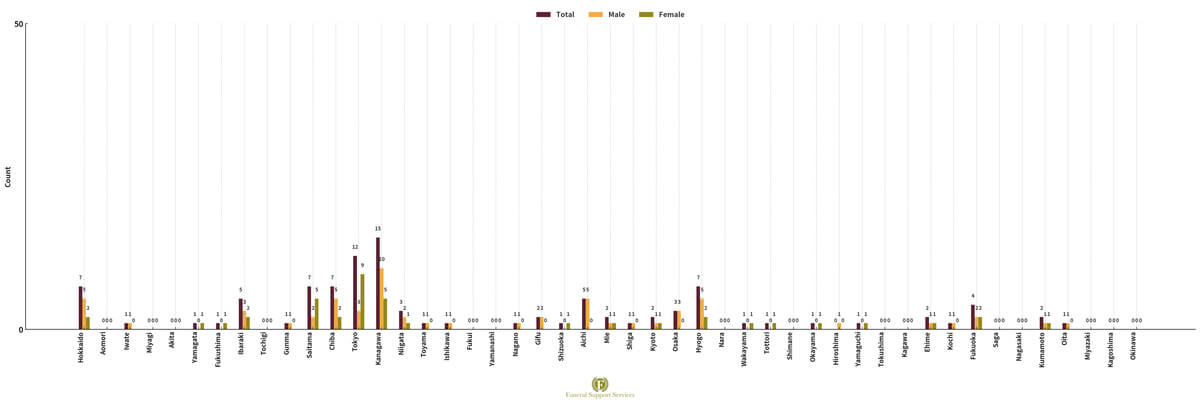
Gender
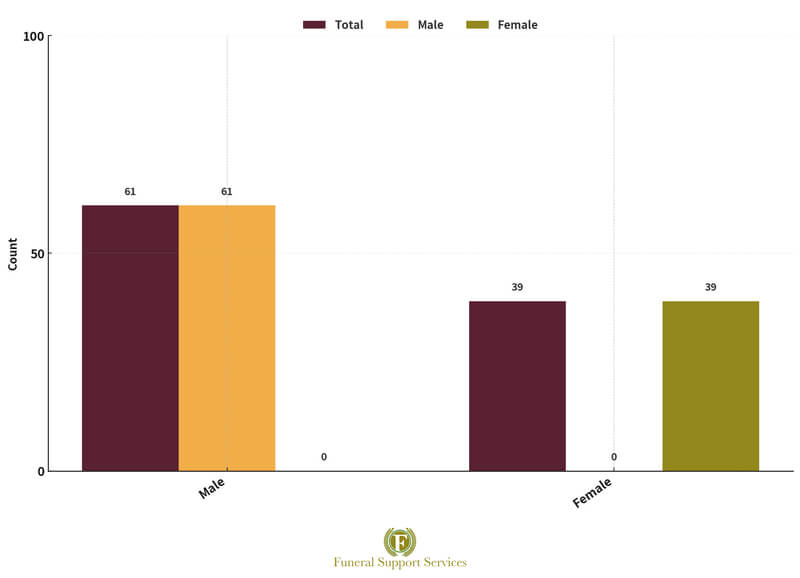
Marital status

Occupation

Industry
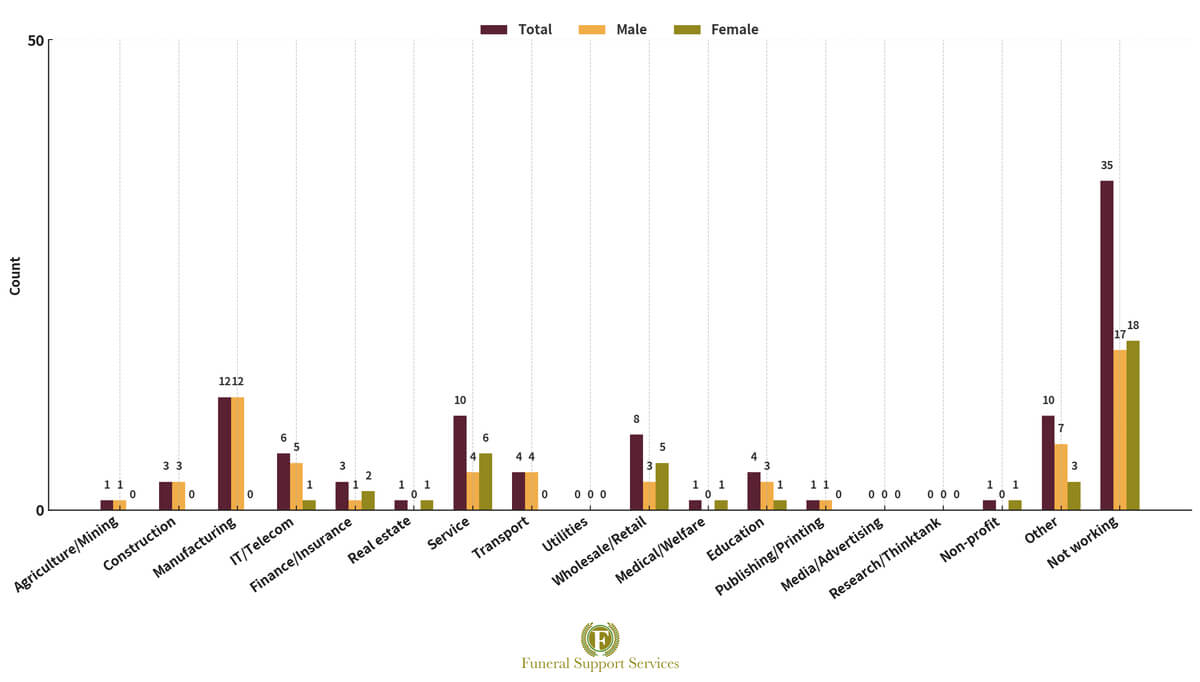
Household income

Housing type

Presence of children
